Another Allsvenskan season has concluded, and for a second season in a row, Henrik Rydström’s Malmö FF have emerged victorious as Swedish champions.
Much has been written about Rydström’s innovative ‘relationist’ tactics in possession, including our tactical analysis in 2023 (linked on the word ‘analysis’).
However, Di Blåe also ended the 2024 campaign with the joint-best defensive record in Sweden’s top flight, having conceded only 25 goals in 30 games.
Malmö’s expected goals against (xGA) tally sat at 31.42 come the end of the campaign as well, placing Di Blåe top of that particular table as well for this year, while no Allsvenskan side allowed their opponents to take fewer shots on their goal than Malmö either this term.
This Allsvenskan tactical analysis focuses on Henrik Rydström’s defensive tactics, particularly how his back four works together to form a solid, protective defensive unit in front of goalkeeper Johan Dahlin.
Malmö’s Defensive Structure & Philosophy
Under Henrik Rydström’s coaching style, Malmö were the most aggressive pressing side in Allsvenskan this season, ending up with the lowest PPDA (8.62) and second-highest challenge intensity (5.9) of any team in the league.
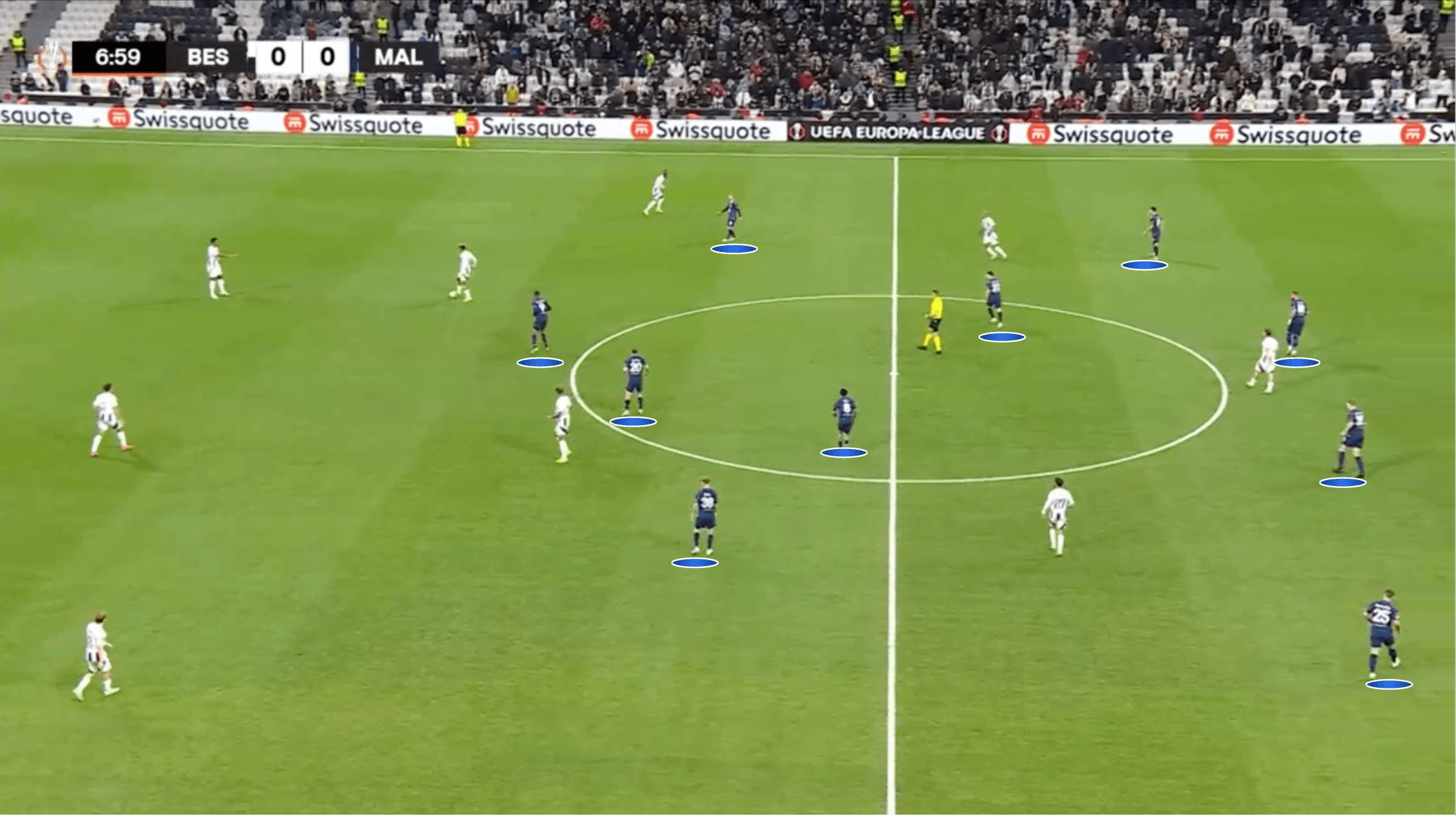
Primarily defending in a 4-2-3-1 formation this season, with the 4-4-2 being just slightly less commonly used, Malmö’s defensive tactics will often see them pressing from a mid-block, with the defensive line typically resting just behind the centre-circle.
Their wingers sit narrow, helping to create a structure that significantly congests the park’s middle, as shown above.
When the opposition inevitably plays the ball wide in search of space to exploit outside this defensive unit, Malmö’s first option is for the winger to react, drop back, and press the wide receiver, allowing the full-back to stay with the rest of the backline.
However, the full-back will jump out from the backline if they’re much closer than the winger to the wide receiver, meaning the rest of the backline has to shift over to cover the space being opened in Malmö’s backline.
This can see the centre-backs often dragged into wide 1v1s, meaning they need to be comfortable defending in such situations.
Meanwhile, the ball-far full-back must be comfortable coming across to defend centrally, including with potential aerial duels.
Malmö FF Full-Backs Scouting Report
The next phase of this scouting report focuses on Malmö’s full-backs, specifically, and their defensive roles under Henrik Rydström tactics.
Gabriel Busanello & Jens Stryger Larsen Defensive Territory Map
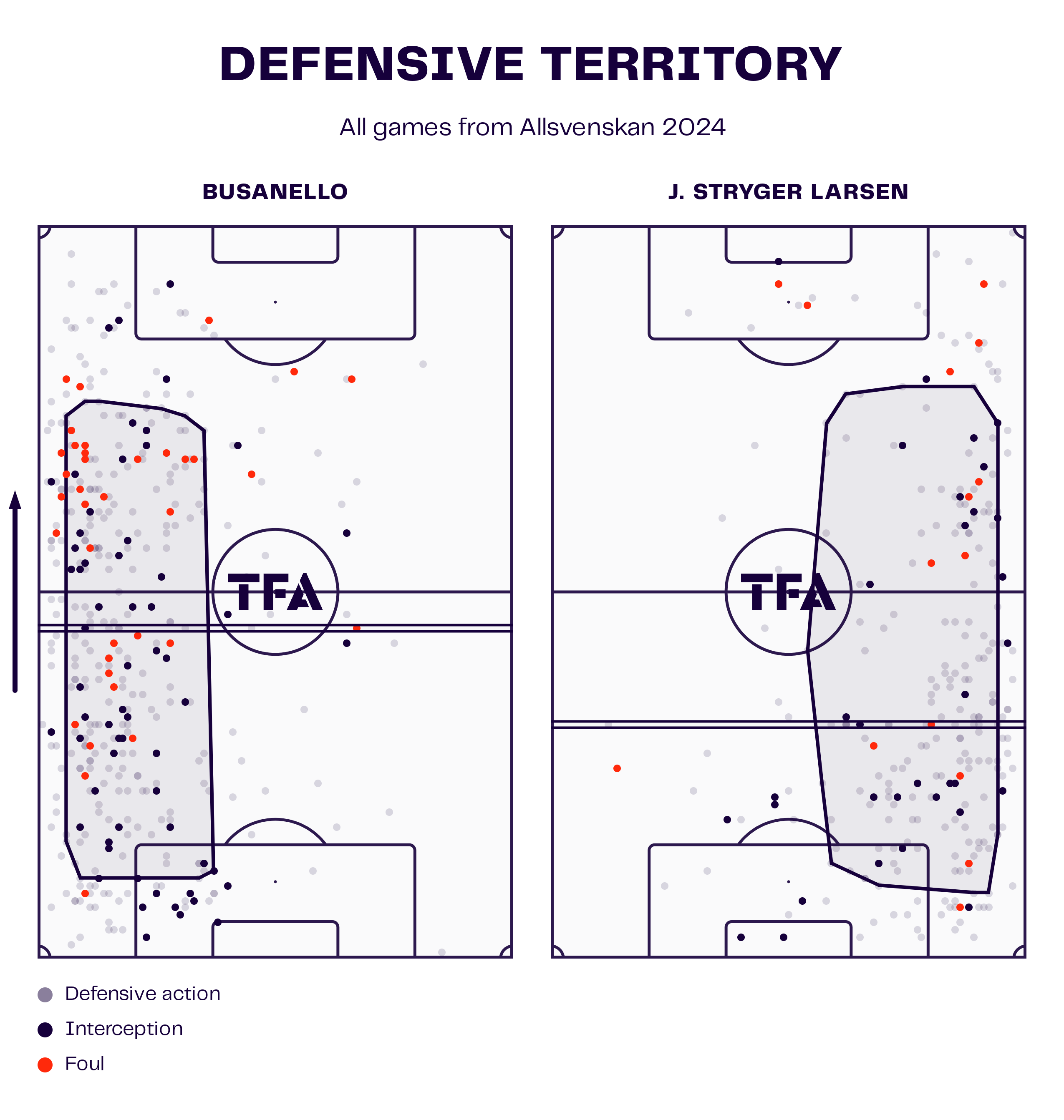
Looking at the respective defensive territory maps of Malmö’s primary full-back duo from 2024 above, we can clearly see a major contrast in the two players’ preferred areas of engagement.
Indeed, both get involved in defensive actions quite centrally — a result of Rydström’s defensive tactics, as we’ll see shortly — but Busanello is far more likely to press high and engage the opposition inside their half of the pitch.
At the same time, Stryger Larsen prefers to defend deeper.
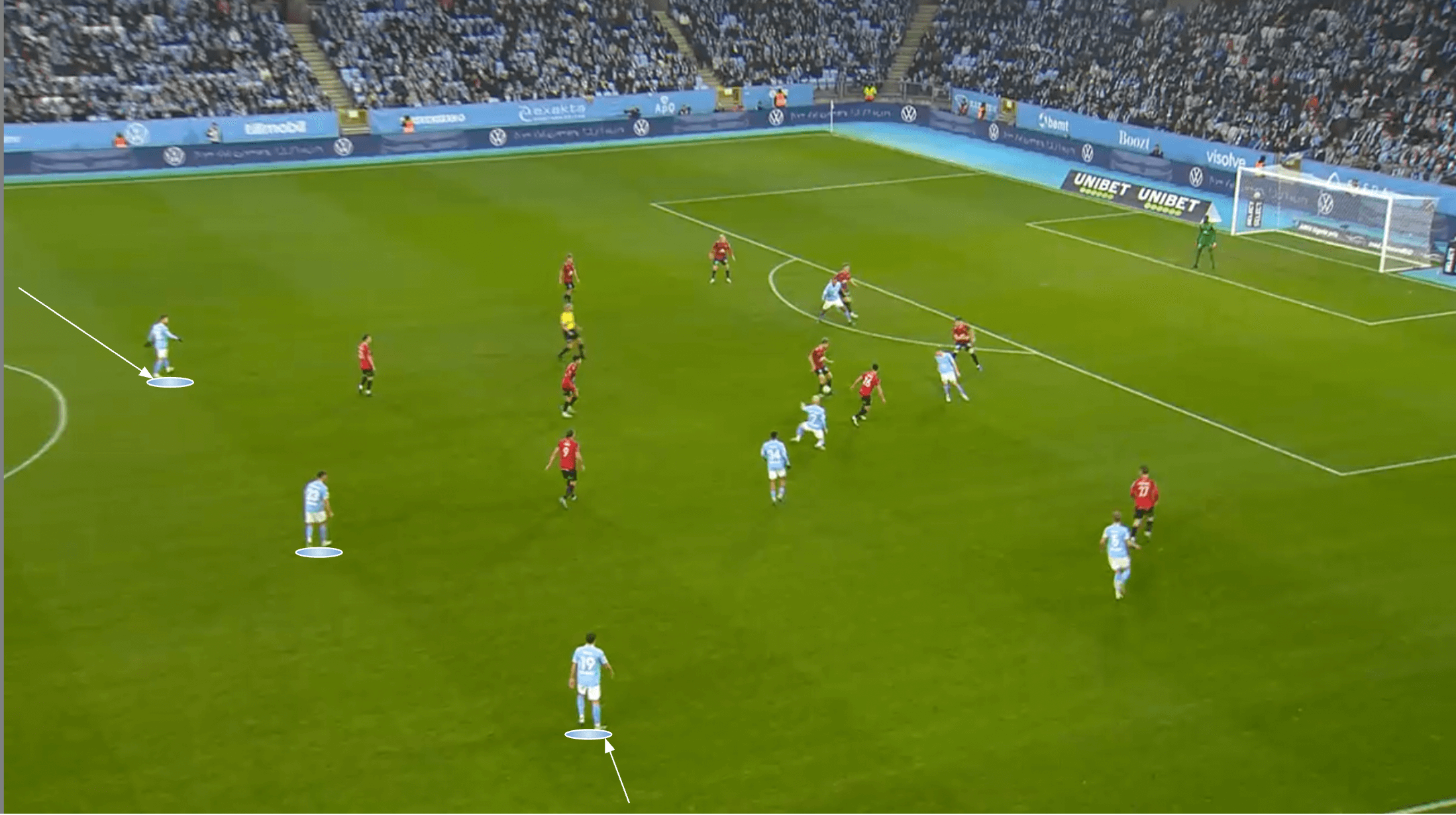
Being a possession-dominant side, Malmö’s chance creation phase sees deeper players ready themselves for a turnover should their opponents win the ball back and try to counterattack them.
Rydström likes a line of three in the middle of the park ahead of the two centre-backs.
The full-backs will often find themselves on the outside of the three.
This is not a given, as sometimes the full-backs — especially Busanello — will get involved further upfield in possession, providing the width inside the final third, leaving perhaps a midfielder to fill in where we see him above.
However, the Brazilian left-back often comes inside to occupy this position and play this role, with the right-back almost mirroring his movement on the other side.
This is why we see plenty of quite central defensive actions in Figure 2 above for both full-backs.
They play a key role in Malmö’s counterattack defence, helping the team shut down dangerous transitional attacks and ensuring they can quickly regain possession to keep pressure on the opponent.
Gabriel Busanello Radar Map
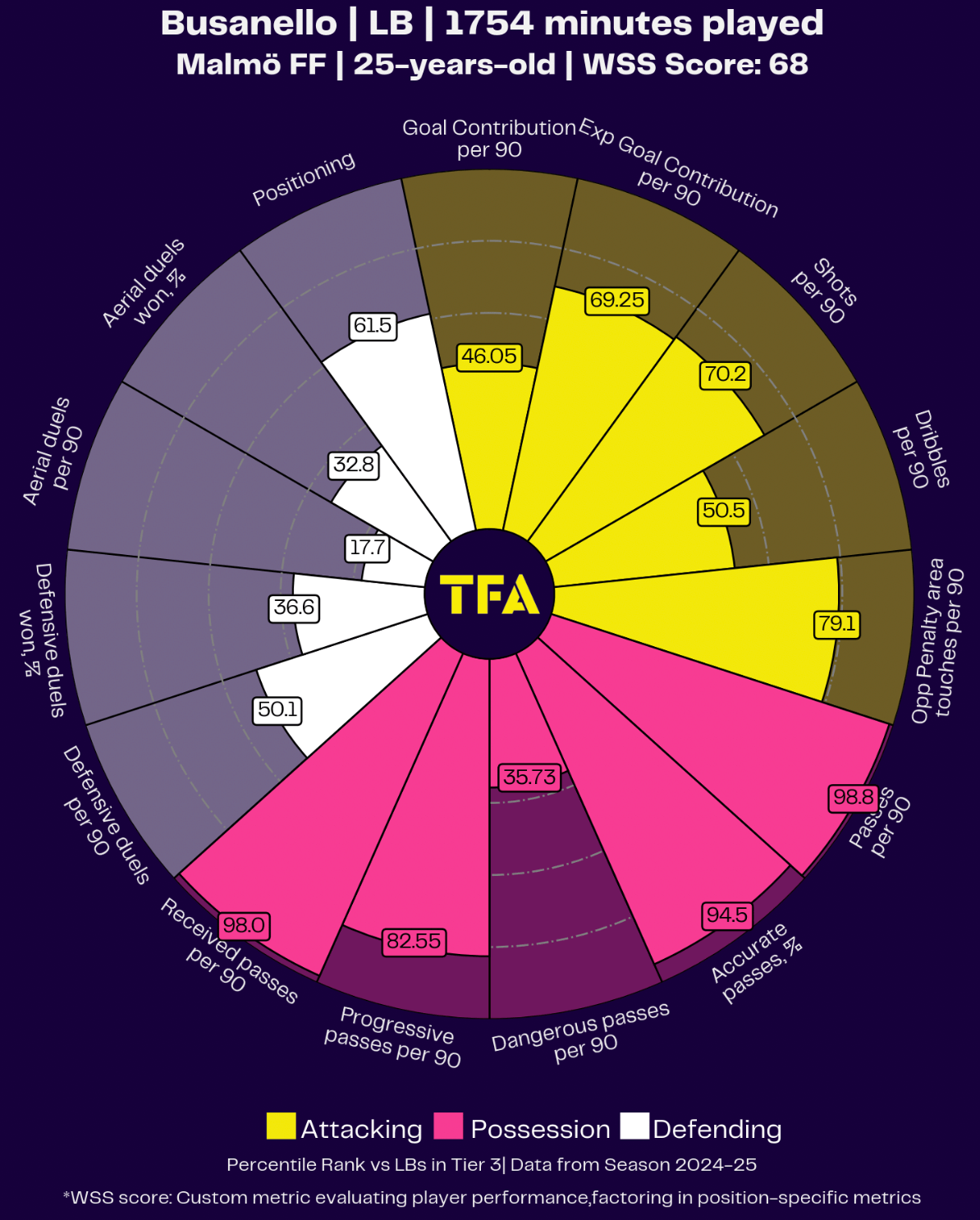
Ignoring the impressive passing and attacking metrics, Busanello’s defensive positioning (a combination of tackles and interceptions) stands out as a positive on the pizza chart above.
At 180cm/5’11”, Busanello’s height is also decent for a full-back, which helps him out in aerial duels even if his percentile ranks in aerial duels per 90 and aerial duel success aren’t exactly stellar.
Even with Malmö being a possession-dominant side, Busanello style of play ranks average among the dataset for defensive duels per 90, highlighting his willingness to get heavily involved in off-the-ball actions.
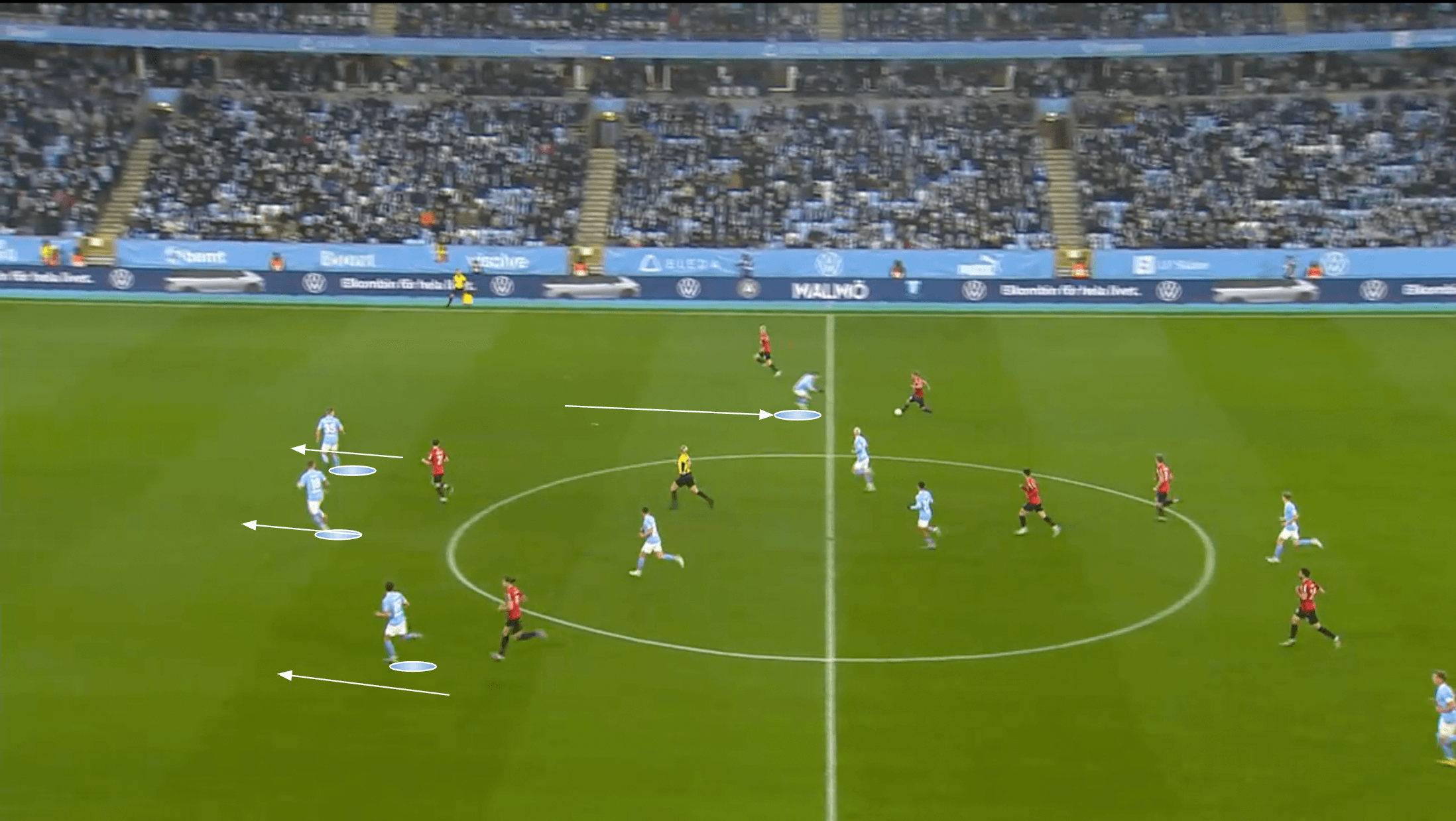
Above, we see an example of Busanello opting to step out and confront a dribbler in a 1v1 at the halfway line.
At the same time, the rest of the backline drops off to protect the space in behind — a great example of the Brazilian’s combative nature as a full-back.
Jens Stryger Larsen Radar Map
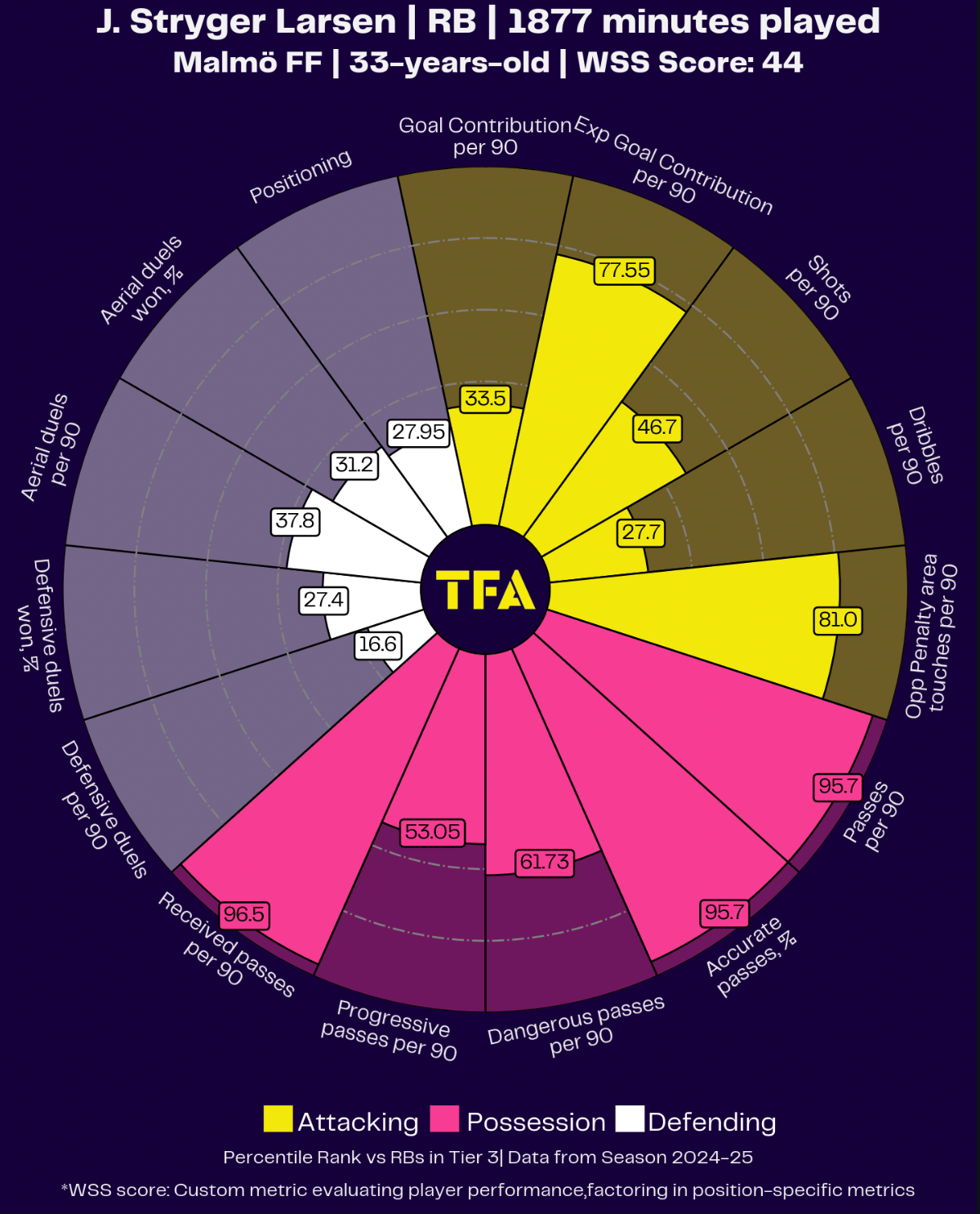
In contrast, as you might’ve guessed from the defensive territory maps in Figure 2, Jens Stryger Larsen’s style of play is very much that of a non-combative full-back, emphasised by his low percentile ranks in defensive duels per 90 and positioning.
At 182cm/6’0”, Stryger Larsen is a decent height for a full-back, helping him out in the aerial duels department, which Malmö sometimes needs.
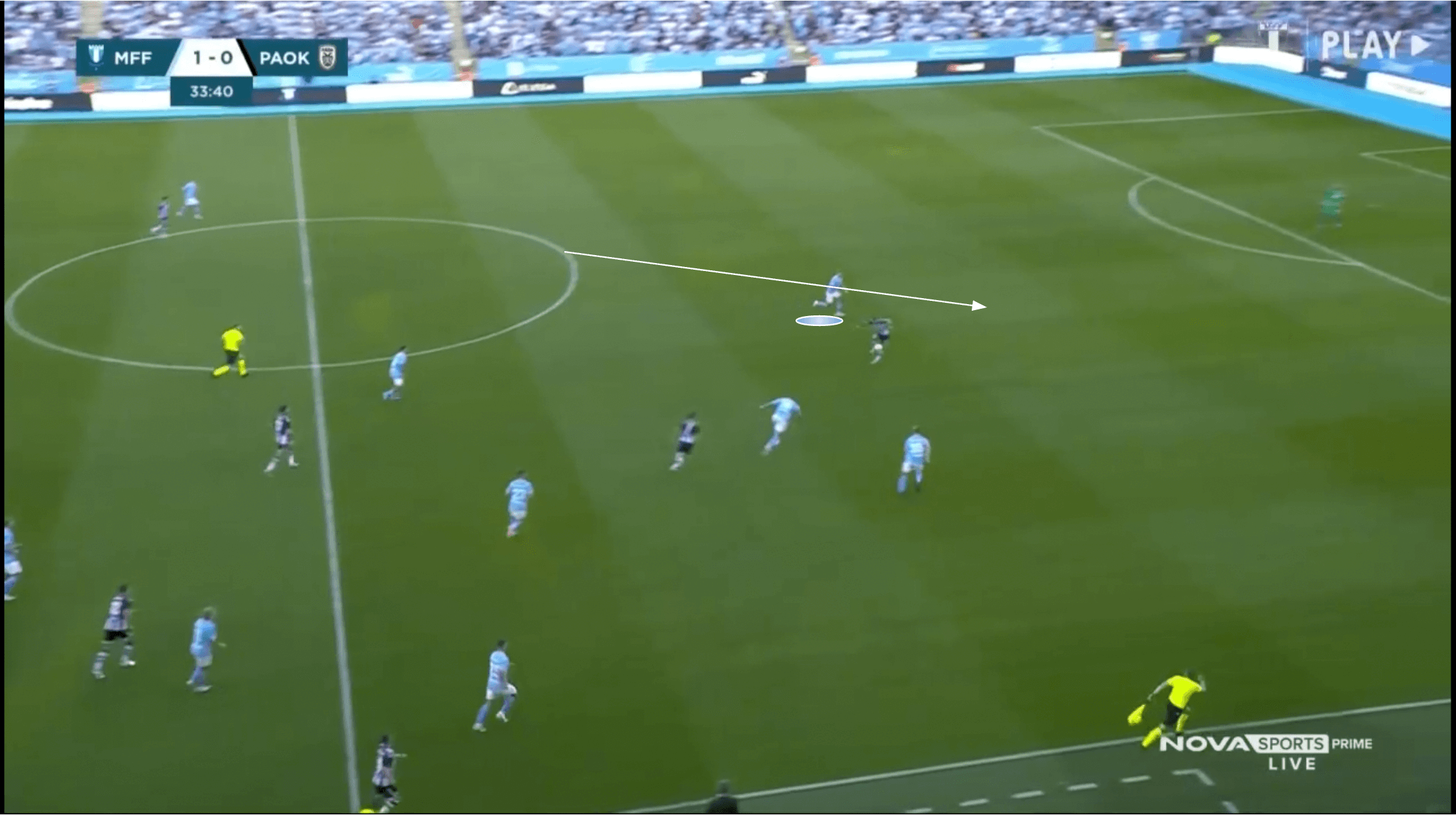
As mentioned earlier, Malmö’s full-backs sometimes have to shift across and defend more centrally.
This can result in them being dragged into aerial duels, first, and then having to cover behind the defensive line, as was the case for Stryger Larsen in Figure 7.
The Dane’s ability to read the game, adequate pace for covering in behind, and more passive defensive style help him perform this role quite effectively.
Malmö FF Centre-Backs Scouting Report
Moving on, let’s examine Malmö’s centre-backs and their defensive roles under Henrik Rydström’s style of play.
Pontus Jansson Scouting Report
Pontus Jansson rejoined Malmö, the club that produced him in his youth, in the summer of 2023 — midway through that title-winning campaign — and quickly became a key figure in the squad on and off the pitch, with the centre-back assuming captaincy duties for many games almost immediately.
The 33-year-old ex-Brentford, Leeds United
, and Torino defender has a big personality on and off the pitch, and Pontus Jansson’s style of play usually dictateshow his teams defend.
In 2024, only one Malmö player, Lasse Berg Johnsen, accumulated more league minutes than Pontus Jansson, highlighting his important role in the team’s tactics and setup.
Pontus Jansson Radar Map
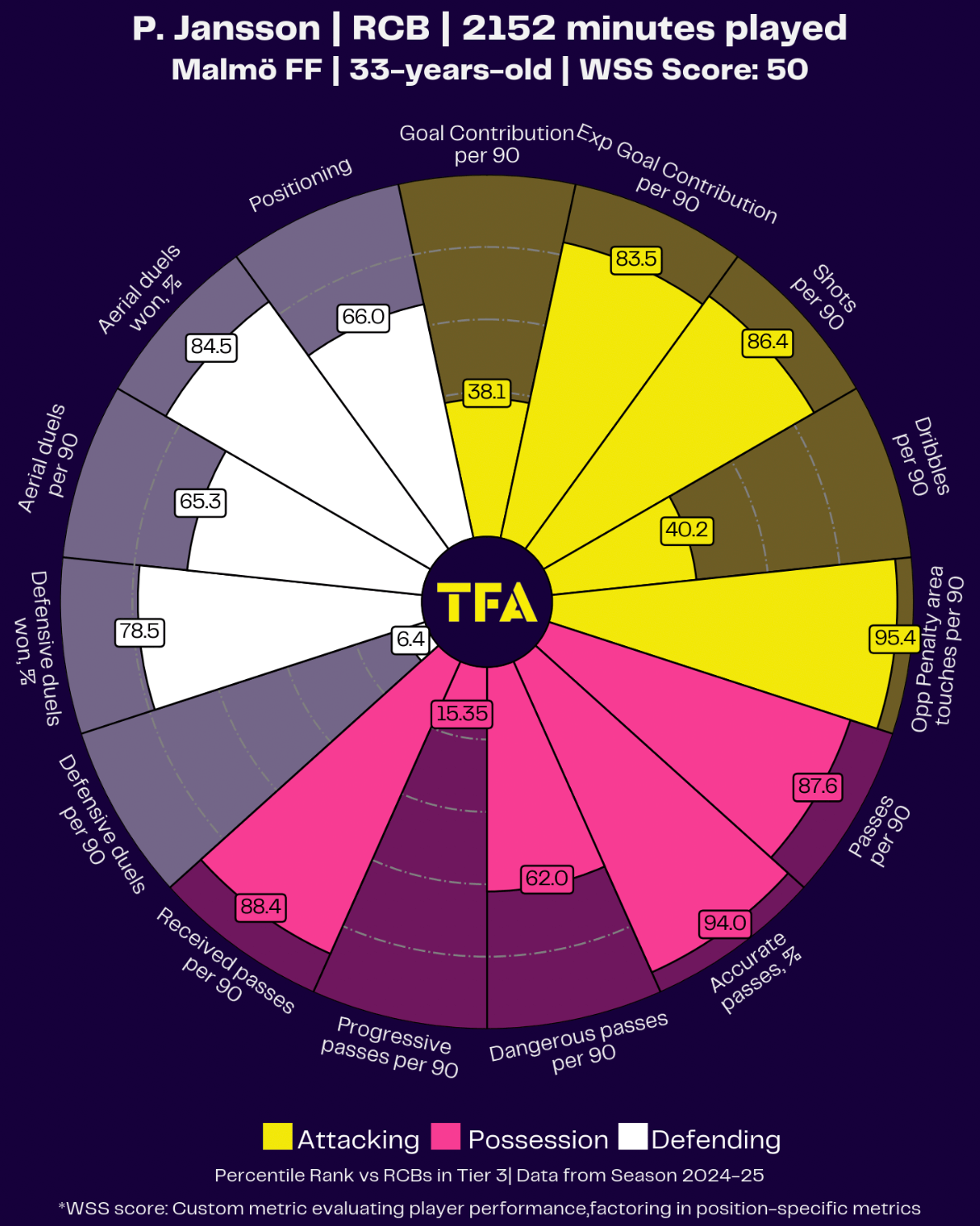
Defensively, Jansson wins a relatively high number of duels compared with others in his position from leagues of a similar level.
Though he doesn’t engage in many defensive duels, as evident from the extremely low percentile rank in that particular metric above, he is happy to defend aggressively and even sometimes follow attackers into midfield or jump out from the backline to engage high.
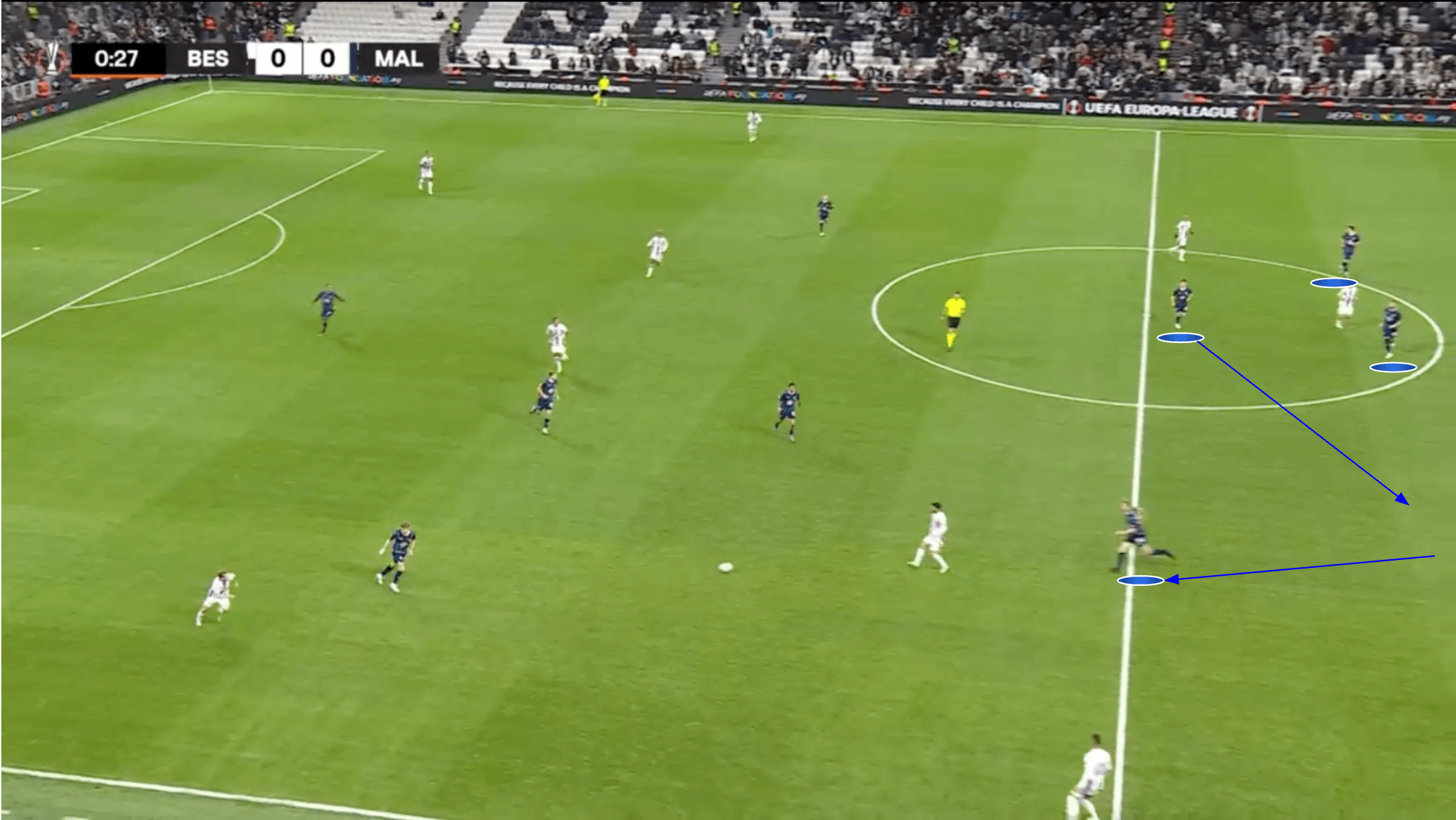
We see an example of this aggression in Figure 9, which prompts Di Blåe’s holding midfielder to drop into the backline, providing cover for the veteran centre-back — much of Malmö’s play involves cooperation, as we see in the image above to maintain balance.
Rydström’s side have mastered this kind of teamwork.
Pontus Jansson & Colin Rösler Defensive Territory Map
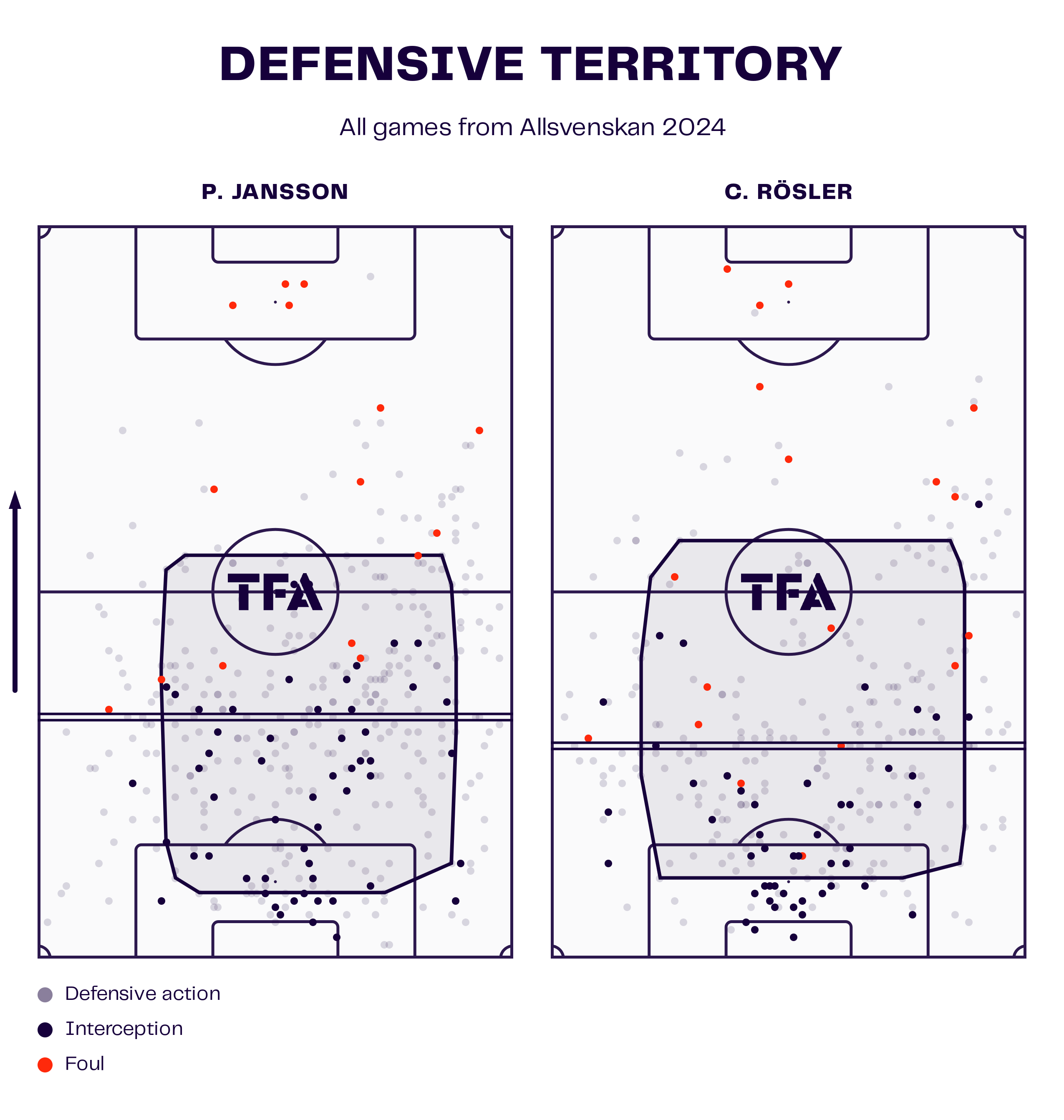
This aggression sees Jansson’s average defensive line resting marginally higher than Colin Rösler, who was signed by Rydström’s side one year after Jansson, in the summer of 2024, from Allsvenskan rivals Mjällby.
Since joining Malmö this past summer, Rösler has become integral to Rydström’s side.
Colin Rösler Radar Map
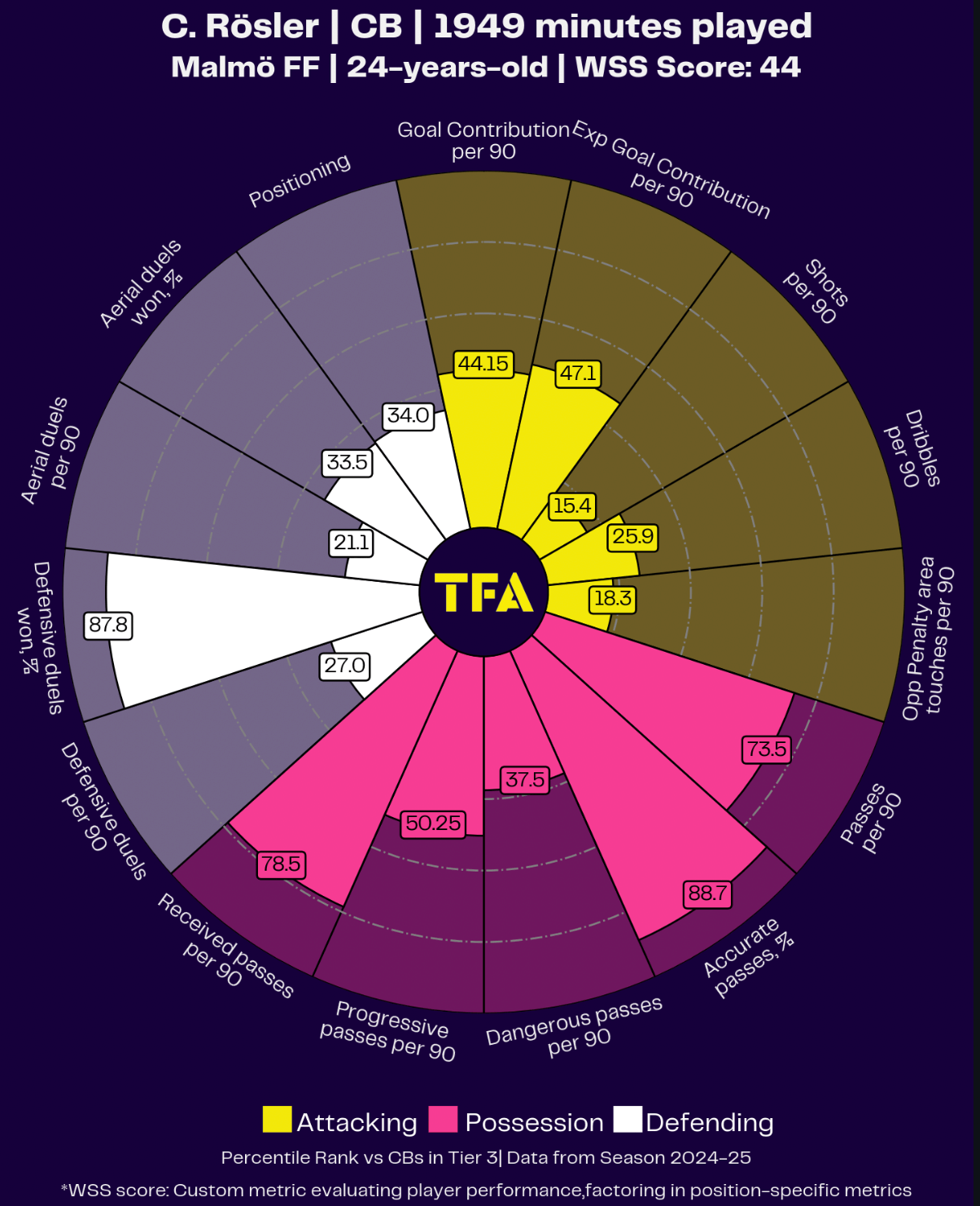
Rösler’s defensive duel success is the biggest standout on his pizza chart in Figure 11; the 24-year-old Norway international is very reliable when he chooses to engage.
Though he defends a little less aggressively than Jansson, he’s also comfortable defending wide in 1v1s, as can sometimes be true within Malmö’s aggressive defensive system.
As time passes, Rösler and Jansson could develop quite a harmonious relationship and formidable partnership, with Rydström’s side already keeping five Allsvenskan clean sheets in their nine league starts together — not a bad record.
Conclusion
To conclude this tactical analysis and team-focused scout report on Rydström’s Malmö, we’ve clearly defined and explained the roles and dynamics of Malmö’s primary backline, illuminating how they combined to form a formidable defensive unit in Allsvenskan this past season.

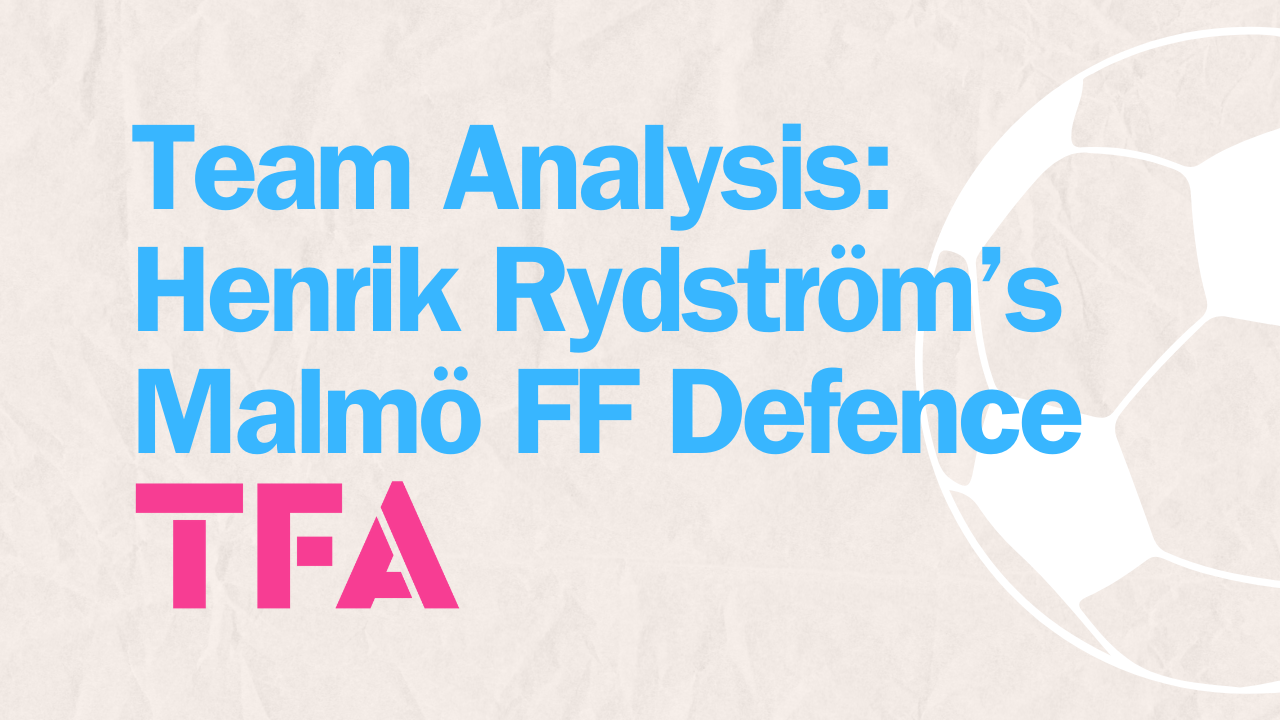



Comments